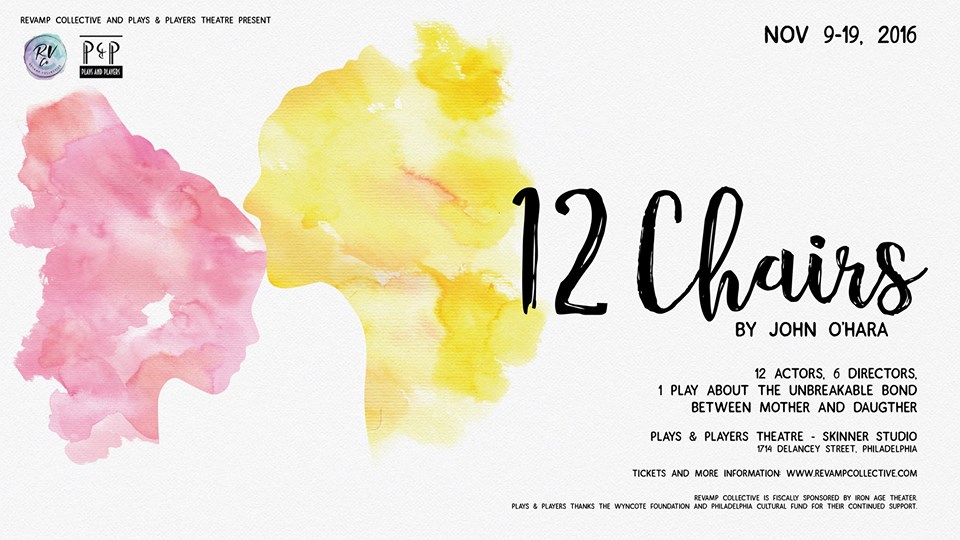 Philadelphia actor and playwright John O’Hara wrote 12 CHAIRS. His plays have been performed onstage at Skippack Playcrafters, the Adrienne, ACT II Playhouse, and Bristol Riverside Theatre among others. As an actor, John has appeared at the Wilma, Walnut Street Theatre, People’s Light and ACT II Playhouse. Witty as always, O’Hara once described himself as “a playwright who yearns to be a waiter in his spare time.”
Philadelphia actor and playwright John O’Hara wrote 12 CHAIRS. His plays have been performed onstage at Skippack Playcrafters, the Adrienne, ACT II Playhouse, and Bristol Riverside Theatre among others. As an actor, John has appeared at the Wilma, Walnut Street Theatre, People’s Light and ACT II Playhouse. Witty as always, O’Hara once described himself as “a playwright who yearns to be a waiter in his spare time.”
12 CHAIRS emerged from O’Hara’s experiences with his mother (Madeline O’Hara, 1926-2011) and some of her relatives at her funeral. It centers on an intensive mother-daughter relationship which “seems to be eternally joyful and frustrating in the cyclical nature of life and its journey,” as O’Hara described it.
It is now onstage with ReVamp Collective (RVC), a woman-centric—though not women-exclusive —theater company in Philadelphia founded by co-artistic directors Carly Bodnar and Erin Carr, with Kristen M. Scatton as the associate artistic director and resident playwright. Six Philadelphia-based directors—Amanda Coffin, Iraisa Ann Reilly, Jess Otterbine, Michelle Pauls, Randi Alexis Hickey, and Zuhairah McGill—were each given the freedom to choose two or three actors, each of whom will present a staged reading of this play twice. None of the directors and actors have seen each other’s work before any of the six opening night performances. It’s rare in theater history for a small, young company to create an opportunity that gives multiple directors the chance to work on the same drama.
As part of the program, RVC invited six women visual artists to create original work based on 12 CHAIRS. Each artist was paired with a director and has explored their director’s vision through visual art. At each performance, audience members will have the opportunity to purchase raffle tickets for original “12 CHAIRS Artwork.” The drawing will take place at the end of the entire run on November 19. Raffle tickets will be 1 for $3, 5 for $10, and 10 for $20. For images of some of the artwork, visit revampcollective.com. Visual artists include Kate Elise, Madison Auch, Gina Rubinetti, Lauren Doyle, and Alexandra Mosoeanu.
[Skinner Studio at Plays & Players Theatre, 1714 Delancey Place] November 9-19, 2016; web.ovationtix.com/trs/pr/964963; revampcollective.com.
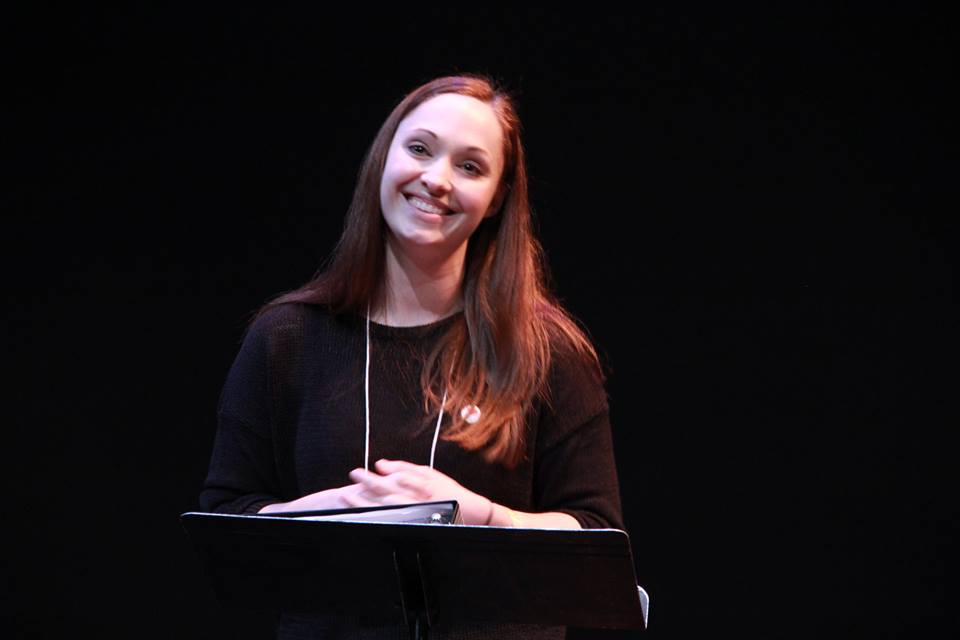
Henrik Eger: When first you saw the script of 12 CHAIRS, what did you think about its content and its dramatic potential?
Amanda Coffin: The concept of ReVamp was the most exciting element of this project for me—six directors working on the same piece is very unorthodox. I was intrigued by that. Because of the freedom given to the directors, I was able to explore some out-of-the-box concepts and I could experiment. In some ways, I felt liberated from having to do it the “right” way. That’s not to say that my current production isn’t “right,” but I think it’s more unorthodox than it would have been had I been the only director working on it. This was an excellent lesson to learn.
Iraisa Ann Reilly: What popped for me was the juxtaposition of musical chairs, the fact that the chairs are eliminated throughout the play, and the idea of who is missing. There are characters in this play that are very present in their absence. I also liked the idea of the age progression as well, and Louise eventually passing mom’s age at the beginning of the play.
Michelle Pauls: I saw and heard about the script many times through John O’Hara, a friend of mine. He said it’s a great vehicle for two versatile actresses—and it is. I also read a new play of John’s about a fading movie star that I really like.
Jess Otterbine: I immediately recognized the circular motion, the spirit of the script. Everything seems to come back on itself in some really interesting ways. The play itself is a large circle-of-life, made up of several smaller circles.
Randi Alexis Hickey: I was immediately drawn to the timeline. Time is a complex influence on any kind of relationship, and it excited me to be given a script that employs time as a character in the telling of a mother-daughter story.
Zuhairah McGill: I thought the script had great dialog. I also like the way playwright John O’Hara involves other characters. However, I felt it was too long for a one-act; it felt more like a two-act play.
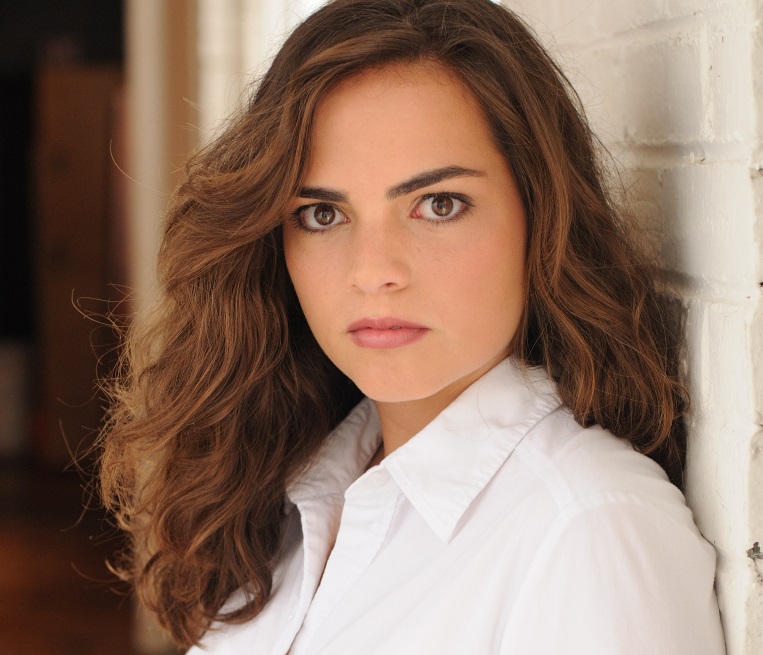
Henrik: Looking at the reality of your work with your cast, what approach or approaches to directing did you finally take for this play?
Iraisa: I knew that I wanted to cast Mom as younger than [her daughter] Louise. In life as in this story, the child eventually becomes the parent or caretaker—something I wanted to stress. I also wanted to accentuate how present Mom was in Louise’s life, even when she wasn’t realizing it. I’ve worked this sense into the transitions of Louise “packing up” what is left of Mom’s few belongings. Mom didn’t save much, but what she did save had to do with Louise.
Amanda: I have two very talented actors, Megan Winch and Peggy Smith, and I was able to rely on them to make strong choices and bring these characters to life. We used a collaborative process that allowed everyone to explore and play, which is how I like to run a rehearsal room.
At the same time, we were limited in the amount of time we had to rehearse, so I came in with a vision and created a shape to the piece within which the actors were able to explore. Since it’s a staged reading, the primary goal is to allow the words to be heard and felt by the audience.
Michelle: I wanted to work with actors I knew could deliver—a short rehearsal period, multiple characters to play, and mother-daughter issues. Plus, I wanted to add something to make it more diverse.
Jess: When working with actors, I like to let them play and make their own choices as freely as possible. Often, I tell them that they can come up with even better interpretations than mine, because that’s what they are trained to do. My job as the director is to be an outside eye and guide for their impulses.
Randi: Because this is a staged reading, and not a production, I started with table work. We had a lot of discussion about these characters’ journeys and the specific language [playwright] John [O’Hara] has given us to work with. This simple and stripped down setup, in a black box theater with scripts in hand, allows and requires me to hone in on the text itself. That was also the focus when putting the script on its feet. All of the blocking comes from the deep understanding and choices we made around the table about the characters in this piece.
Zuhairah: Well, when working with the three wonderful actors I had cast—Jaylene Clark Owens, Cathy Simpson, and Jaron C. Battle-Whitehead—it wasn’t hard at all. We discussed the piece and what I was looking for in movement and they got it.
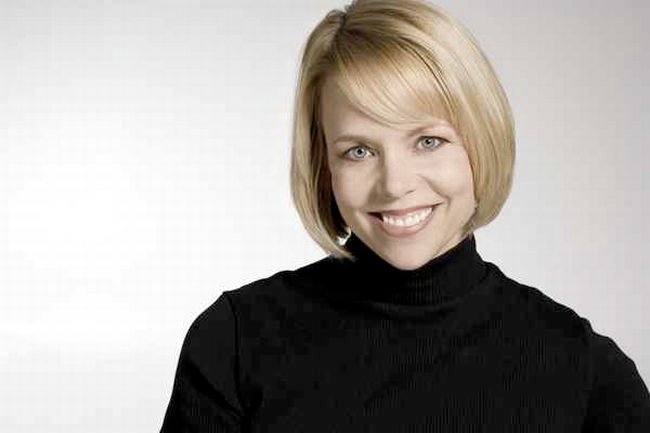
Henrik: What response did you get from your cast?
Michelle: My cast—Christina May and Meryl Lynn Brown—was great. And as we rehearsed, we would talk to the imaginary audience members, when the idea hit me for the hook: we would use the audience to play different ancillary roles, making some sound effects and getting the audience involved as co-creators, since theater is a team sport.
Amanda: In my experience, having six different casts created a great sense of unity cast-to-cast. In some sense, it brings up everyone’s game because you know other people are working on the same text. There isn’t pressure to be “better” necessarily, but there is the understanding that other people are working hard on this piece to bring it to life. That allowed us to come together to create a strong showing.
Of course, there are always moments when actors wonder if a director has lost her mind, but I was blessed to have actors who were excited to try everything.
Iraisa: My actors, JJ Van Name and Rupal Pujara, were great to work with. They were on board and helpful in making suggestions, letting me know what didn’t feel right, what clicked, and ultimately, what would make this a clearer, stronger piece than what I had envisioned.
Jess: My beautiful and brilliant group of actors—Elise D’Avella, Katherine Perry, and Lexi Schreiber—have gone along on the ride with me every step of the way. Their trust in me and their willingness to take risks makes me feel honored to get to work with them.
Randi: The response from my cast was what I had hoped, and always hope to have in any future process. We had a week of rehearsals and two hours of tech, and in that short time I was able to have an intelligent and challenging discussion with [actors] Kyra Baker and Jenn MacMillan about the play and its relevance to our own experiences.
With 12 CHAIRS as the catalyst, we got to talk about the expectations on women in relationships of all kinds. When I threw something out onto the table that either of them had a different experience with or view on, we were able to discuss that and come to the conclusion that best served the play.
Zuhairah: The biggest thing about directing actors of this level, Barrymore actors, is that they come ready to work—expecting you to do the same. The key word is trust. They trust me to take them on the journey—without fear.
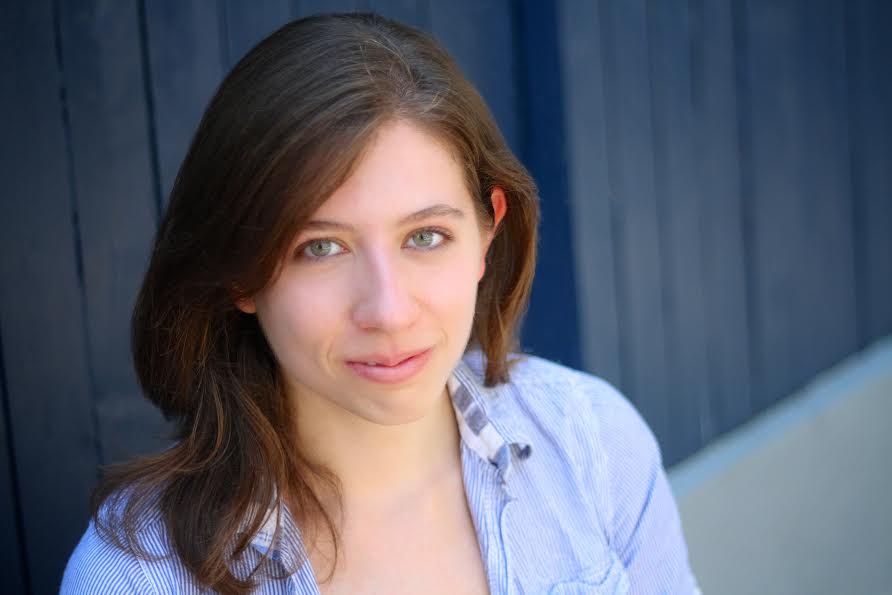
Henrik: Which parts of your background as an actor, director, theatergoer, etc. helped you in directing this play? Were you willing to take some risks or did you stay in a more safe and traditional mode?
Jess: Most of my training comes from movement-based, collaborative theater. Being a movement instructor as well as an actor who approached work this way, I wanted to include in my production elements from the physical-theater world. This was a risk that I think is paying off quite nicely. The collaborative element has also been wonderful because I have full faith in my actors and they have full faith in me. The environment is supportive and buzzing with creative energy.
Amanda: My background is primarily in directing, and I definitely used the skills I’ve gained as a director to bring my piece to life. Because my time for rehearsal was brief, it was important to make a strong plan and present a vision. My experience gave me the confidence to take risks with the piece.
For a piece that spans decades, I started with the concept of time passing. How do we show passage of time? How do these two actors age throughout the piece? Can we make the audience feel like they’re coming through the years with us?
For me, music was the answer: Disco takes us to the 70s. New Wave to the 80s. Boy bands and pop to the 90s. Of course, genres break the bounds of particular decades, but there is nothing like Christina Aguilera’s “Genie in a Bottle” to transport us directly to 1999. My piece became a journey through the decades with music as the catalyst.
Iraisa: Primarily, I am an actor and playwright, so I think sometimes I tend to put the playwright hat on when filling in some of the blanks that exist in any play. I create the story that is not on the page and tend to do this as an actor as well when I am coming up with a “backstory” for a character. Sometimes, I wonder if a playwright will respond positively to my decisions and if those decisions are supported by the text. In that sense, I would say I took some risks.
Michelle: I have an extensive improv background, and my actors are very good at improv, too, which helps.
Randi: I do have some experience with new scripts. For instance, I worked on the premiere productions of Dream House by Jeremy Gable, The Artist Manifesto by Adam Howard, and I Know The Way Home by Sarah Galante, which are all experiences that taught me how to really look to the script when I feel lost.
When an answer wasn’t obvious [in the reading of 12 CHAIRS], there were plenty of other images to draw on that lead us forward. The words the playwright has set down are there for a reason, even if only to raise questions that lead to a rewrite. I’ve also done a fair amount of devising and improvising, which proved useful when I had to figure out how to represent places in the story, like the bar at a wedding or the auditorium at a high school.
Zuhairah: All of my background helps me through the process. I think directors should always be in tune with all aspects of their training, because these aspects have their own rhythm that come together as one. Of course, I took risks, too.
I’m the artistic director of First World Theatre Ensemble—known in Philadelphia for taking risks—but you have to come see 12 CHAIRS to find out the risks that were taken.
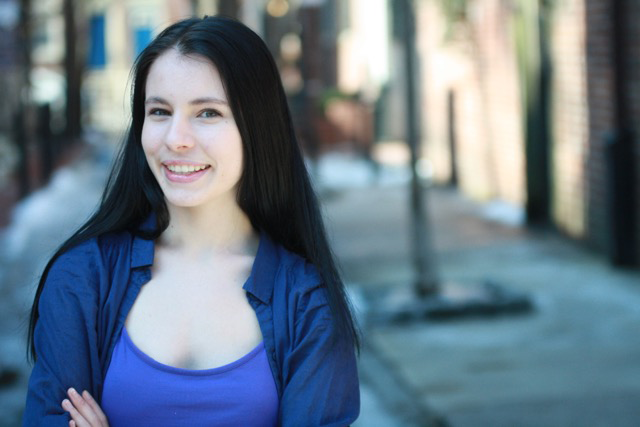
Henrik: Having worked on this play about a mother and her daughter, what did that bring up for you in your own relationship with your mother?
Randi: I haven’t talked to my mother in a very long time, and this play mirrors that circumstance in a lot of ways. The scenes generally take place five years apart, and in turn present Louise and Ann with an opportunity every five years to either repair or further damage their relationship.
Amanda: I think everyone has complicated relationships with their mothers. I’m close to mine, but we’re not without our challenges. She still lives in New Hampshire where I grew up, so the distance keeps us from seeing each other often. This piece has made me think about my time with her—am I waiting to say things that need to be said? Am I waiting to ask questions?
Recently, on a visit home, my mom and I were driving when a particular spot on the road made her remember driving over that very bridge as a teenager. It made me realize how many small moments exist in my mom’s past that I don’t know about.
Iraisa: While my mother and I are different from Louise and her mother, we are very close, and I was able to connect to the idea that spirits surround us every day. I am a spiritual person, so it was not difficult to grasp the way that the afterlife is very present in this play—something that is as real to me as breathing.
Michelle: Themother and daughter relationship is a complicated thing. I have a mother and a daughter. I can hear my mother in some things I hear myself saying to my daughter—things I thought would never come out of my mouth.
I think everyone’s mother does the best she can in raising her children. I know I do, and I think there is always more I could do. I want to raise my daughter to think for herself, to stand by her convictions, and to know it’s okay [for all of us] to try to make the world a better place than what we started with.
Jess: My mother passed away after a long illness a few years ago when I was 22 years old. I love my mother and feel a deep spiritual connection to her—even now. Knowing what it is like to lose a mother definitely affected my approach to this play. I relate very much to Louise. My relationship with my mother was not perfect, but I would give anything to have one more day with her, even if we were arguing. And when Louise comforts Mom as she dies, I see myself and weep with gratitude that life goes on.
Zuhairah: I had moments when it broke my heart to see the relationship between the two of them. I kept saying to myself, “Please find a common ground and move forward.” But that’s easier said than done.
Mother and daughter relationships are hard because they often see themselves in each other. I had a good relationship with my mother. My daughter and I have a good relationship, too. Of course, there were bumps in the road, but forgiveness and love can be powerful.
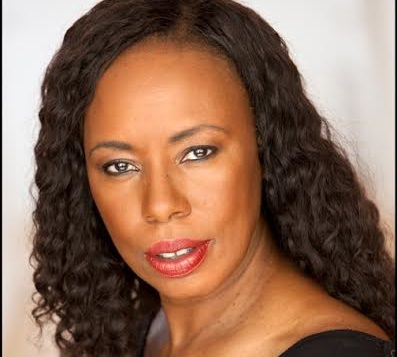
Henrik: Is there anything else you would like to share?
Zuhairah: Thank you all for coming, enjoy the show. . . .
Amanda: There are young, talented female directors in Philadelphia making interesting art. [Readers,] make it a goal to get out there and see their work. Hire them and see what they can bring to your theater.
Writing this on Election Day, when our future is uncertain, I am struck by the necessity of art and particularly new art that has important things to say. Art that can change the world. Let’s engage every generation of theater-goers and non-theatergoers. My version of this play will likely speak to the millennial generation more than the baby boomers, because I am representing them. I think that is a great thing.
Iraisa: Theater is a communal, spiritual experience where a group of strangers gathers in the same room and brings its personal histories into an environment where they experience the play in their own way. I strive for the audience to recognize themselves. I want people to come to a play I’ve written, performed in, or directed, and say, “Huh. I guess I’m not the only one.”
I hope everyone relates to 12 CHAIRS—male, female, any ethnicity.Thanks to Revamp and to all those who support this work.
Michelle: I believe theater can change the world, and I believe the world can always use some changing—especially right now.
Randi: This is a play about the complex connection we have with our blood relatives, and how it can simultaneously be a lifeline as well as something completely unhealthy. Thanks to my cast and to ReVamp for having facilitated an important conversation through this presentation of 12 CHAIRS.
Zuhairah: . . . and whatever problems you are having with your mother or daughter—two words: Fix it! And God bless.
[Skinner Studio at Plays & Players Theatre, 1714 Delancey Place] November 9-19, 2016; web.ovationtix.com/trs/pr/964963; revampcollective.com.
